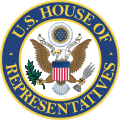| This article is part of a series on the |
| United States House of Representatives |
|---|
 |
| History of the House |
| Members |
| Congressional districts |
| Politics and procedure |
| Places |
The self-executing rule, also known as "deem and pass" is a resolution that a bill be deemed to have passed (or, more commonly, a resolution that a bill be deemed to have passed with a certain amendment); if the resolution passes, the bill is automatically deemed to have passed with the amendment set forth in the resolution itself. This procedural measure has been used by the United States Congress to approve a legislative rule that contains such a provision, the House of Representatives then deems a second piece of legislation as approved without requiring a separate vote, as long as it is specified in the rule. That is, if the vote on the rule passes, then the second piece of legislation is passed as part of the rule vote.
Contents
When considering a bill for debate, the House must first adopt a "special rule" for the debate as proposed by the House Rules Committee. The special rule is a resolution which specifies which issues or bills are to be considered by the House, how much time allotted for debate on such matters, and which proposed amendments will be allowed to be voted on. If the House votes to approve a rule that contains a self-executing provision, it simultaneously agrees to dispose of the separate matter as specified by the rule. For example, modifications or amendments can be approved while the underlying bill is also approved at the same time. [1]
The procedure is often used to streamline the legislative process, although some legal scholars question whether the process is constitutional. [2] [3]